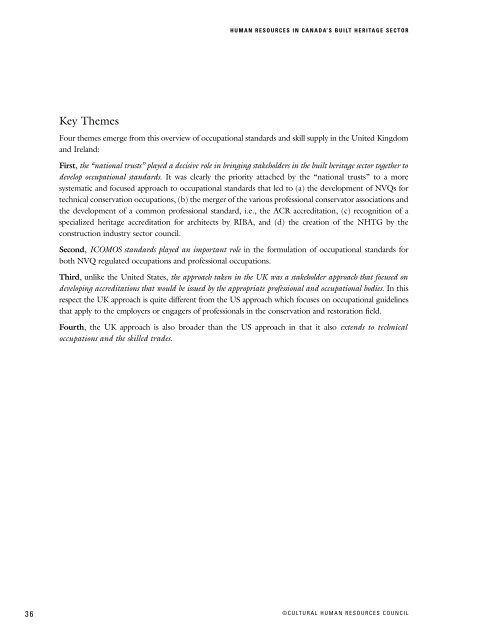Human Resources in Canada's Built Heritage Sector: Mapping the ...
Human Resources in Canada's Built Heritage Sector: Mapping the ...
Human Resources in Canada's Built Heritage Sector: Mapping the ...
- No tags were found...
Create successful ePaper yourself
Turn your PDF publications into a flip-book with our unique Google optimized e-Paper software.
HUMAN RESOURCES IN CANADA’S BUILT HERITAGE SECTORKey ThemesFour <strong>the</strong>mes emerge from this overview of occupational standards and skill supply <strong>in</strong> <strong>the</strong> United K<strong>in</strong>gdomand Ireland:First, <strong>the</strong> “national trusts” played a decisive role <strong>in</strong> br<strong>in</strong>g<strong>in</strong>g stakeholders <strong>in</strong> <strong>the</strong> built heritage sector toge<strong>the</strong>r todevelop occupational standards. It was clearly <strong>the</strong> priority attached by <strong>the</strong> “national trusts” to a moresystematic and focused approach to occupational standards that led to (a) <strong>the</strong> development of NVQs fortechnical conservation occupations, (b) <strong>the</strong> merger of <strong>the</strong> various professional conservator associations and<strong>the</strong> development of a common professional standard, i.e., <strong>the</strong> ACR accreditation, (c) recognition of aspecialized heritage accreditation for architects by RIBA, and (d) <strong>the</strong> creation of <strong>the</strong> NHTG by <strong>the</strong>construction <strong>in</strong>dustry sector council.Second, ICOMOS standards played an important role <strong>in</strong> <strong>the</strong> formulation of occupational standards forboth NVQ regulated occupations and professional occupations.Third, unlike <strong>the</strong> United States, <strong>the</strong> approach taken <strong>in</strong> <strong>the</strong> UK was a stakeholder approach that focused ondevelop<strong>in</strong>g accreditations that would be issued by <strong>the</strong> appropriate professional and occupational bodies. In thisrespect <strong>the</strong> UK approach is quite different from <strong>the</strong> US approach which focuses on occupational guidel<strong>in</strong>esthat apply to <strong>the</strong> employers or engagers of professionals <strong>in</strong> <strong>the</strong> conservation and restoration field.Fourth, <strong>the</strong> UK approach is also broader than <strong>the</strong> US approach <strong>in</strong> that it also extends to technicaloccupations and <strong>the</strong> skilled trades.36©CULTURAL HUMAN RESOURCES COUNCIL










